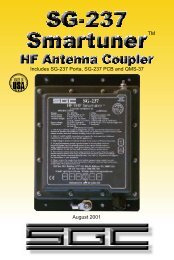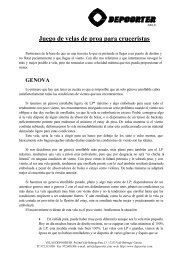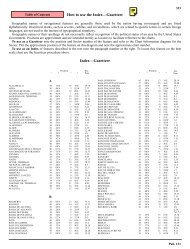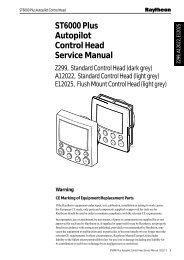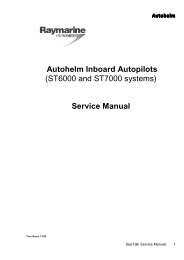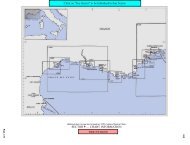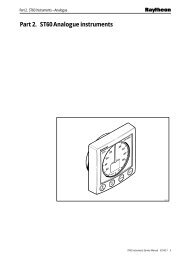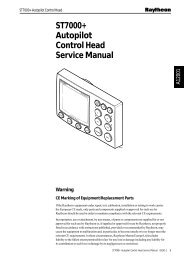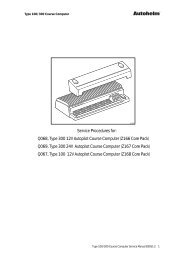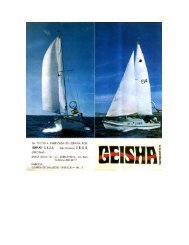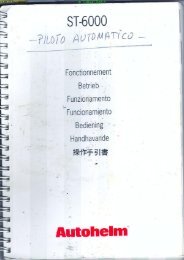Create successful ePaper yourself
Turn your PDF publications into a flip-book with our unique Google optimized e-Paper software.
85SECTOR 8WEST COASTS OF GREECE AND ALBANIA—NISOS OXIA TO KEP I KEFALI8.0 Plan.—This sector describes the W coasts of Greece andAlbania between Nisos Oxia and Kep i Kefali and the off-lyingislands. The descriptive sequence is NNW from NisosKefallinia to Kerkira (Corfu).General Remarks8.1 Winds—Weather.—Over the open sea W of Greece,winds of gale force have been observed at times from early Novemberuntil the middle of March. However, they are almostunknown from May to September. Local squalls are quitecommon along this coast during the summer months, especiallyduring windy weather.8.1 On the coast of Greece fog is uncommon. It usually forms atnight and clears soon after sunrise. Calms or light winds frombetween SE and W and a clear sky are favorable for formation.8.1 Rain usually falls in the winter from September to April butthe summer, as a rule, is rainless.8.1 Tides—Currents.—Off the W coast of Greece, a generalcurrent sets from the Kikladhes (Cycladhes) along the coastand into the Adriatic Sea. Its strength is greatest near the coastand decreases with the distance offshore. Its average velocityoff the coast of Greece, with good weather, is from 0.5 to 0.7knot. With strong W and SE winds, the velocity is increasedconsiderably.Nisos Kefallinia—South Coast8.2 Nisos Kefallinia (38˚10'E., 20˚35'E.), the largest ofthe Ionian Islands, lies in the W approach to Patraikos Kolpos.The island is mountainous and irregular in shape. Oros Ainos,its summit, is 1,618m high and stands in the S part of theisland. Argostolion, the largest town, is situated in the W partof the island and fronted by a roadstead which can be used bylarge vessels.Akra Mounda (38˚04'N., 20˚47'E.), the SE extremity of theisland, consists of a steep cliff, 30m high, which descends to alow plain on its N side. A reef, with a least depth of 2.4m, extendsup to about 1.7 miles SE from this cape. When roundingthis cape, vessels are advised to give it a wide berth.8.2 Akra Katelios, marked by a light, is located 1.9 miles WNWof Akra Mounda. Several prominent white cliffs, 61 to 91mhigh, extend to the W of this point.8.2 A submarine cable extends SSE from a point on the shoreclose NE of Akra Katelios and anchoring is prohibited in itsvicinity.8.2 Akra Liakas, a low shelving point, is located 10.5 milesWNW of Akra Mounda and rises gradually inland to cultivatedland. Several sunken rocks front this point and Danistri Rock,2.7m high, lies 0.5 mile SSW of it.8.2 Akra Ayios Nikolaos, located 4.2 miles NW of Akra Liakas, is alow shelving point which is fronted by an islet and several rocks.A monastery, with a high tower, stands 0.8 mile ENE of this pointand a prominent white house is situated 0.5 mile E of it.8.2 Nisos Vardhianoi (38˚08'N., 20˚26'E.), a low and narrowisland, lies about 1.5 miles offshore, 2.8 miles SW of AkraAyios Nikolaos. This island is surrounded by a reef which hasdepths of less than 9m and extends up to 0.3 mile S and 0.5mile W of it. A light is shown from a structure, 8m high, standingon the SE part of the island. The passage lying between thisisland and mainland to the N is mostly foul and should not beused except by small vessels with local knowledge.8.2 Kolpos Argostoliou (38˚09'N., 20˚28'E.), a long and narrowgulf, indents the W part of the S coast and is entered betweenAkra Ayios Yeoryios, located 1.5 miles NNE of NisosVardhianoi, and Akra Lardhigos, 1.8 miles E. A conspicuousconcrete works stands on the S side of the latter point. Depthsin the gulf range from 18 to 28m in the fairway and shoalgradually to 11m and less near the head. The land on the E sideof the gulf is backed by high, steep mountains, whereas theland on the W side is comparatively low.8.2 Northeast and SE winds prevail in Kolpos Argostoliouduring the winter months, while NW winds prevail during thesummer months. Heavy squalls occur frequently during thewinter months.8.2 Lixourion (38˚12'N., 20˚27'E.), a small harbor, lies on theW side of the gulf and is protected by two breakwaters. Theentrance is 370m wide and there are depths of 4 to 5m in theharbor. Anchorage can be taken by large vessels, in depths of11 to 18m, mud, about 0.3 mile NE of the entrance.8.3 Argostolion (38˚11'N., 20˚31'E.) (World Port IndexNo. 41790) is the largest town on Nisos Kefallinia. It is situatedon the W side of a sheltered inlet which lies between apeninsula extending N from Akra Lardhigos and the mainlandto the E. A main commercial quay, 210m long, fronts the townand has depths of 5.5 to 7m alongside. An approach channel,with depths of 6.1 to 7m, leads to this quay which can accommodatevessels up to 5.5m draft. A prison building stands nearthe N end of town, a group of windmills and a chapel at acemetery situated on the SE side of the inlet, and an obeliskstanding near the center of a causeway at the S end of the inletare all conspicuous and easily identified. Vessels can alsoanchor or secure to mooring buoys to work cargo. Large vesselsusually anchor near the middle of the inlet, in a depth of18m, soft mud. Pilotage is compulsory for all foreign vessels.Pilots can be contacted by VHF and board at the N end of theinlet.8.3 Two submarine pipelines, marked by lighted buoys, extendup to 240m seaward from a power station which stands on theside of the inlet.8.3 Caution.—Due to changes in depths and terrain resultingfrom earthquakes, all vessels entering the gulf should use extremecaution.Pub. 132



